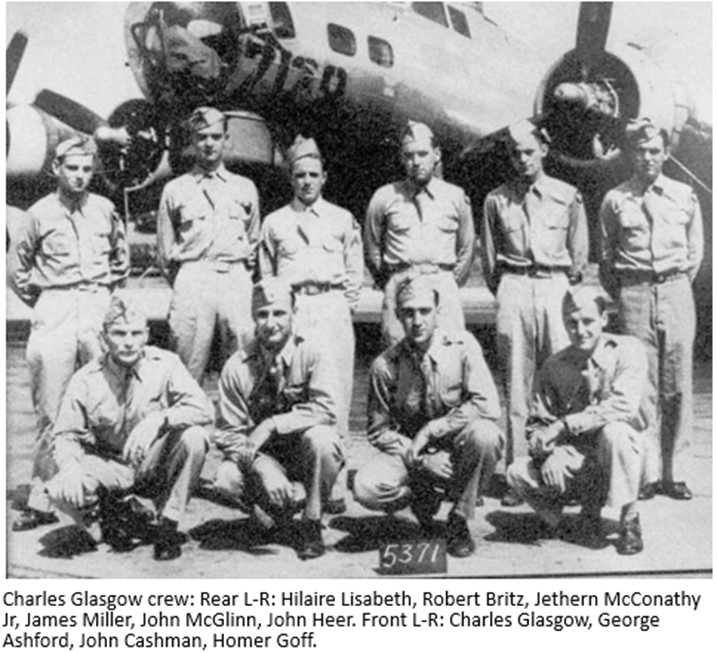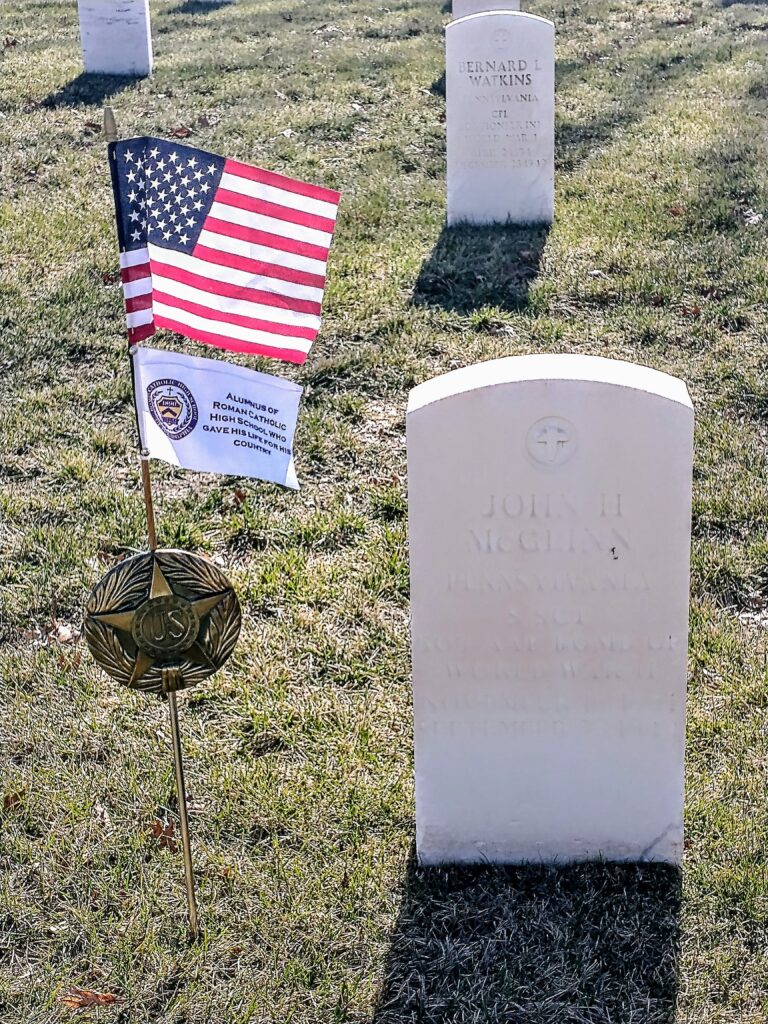‘Masters of the Air’ and Roman Catholic High School
It was sometime in 1948, and in the woods of the small German village of Heerte, 20 kilometers south of Brunswick, a special Allied disinterment unit was completing the grim task of unearthing a mass grave containing the bodies of 35 Russians. The unit also unexpectedly found an additional body in a nearby small hollow. And then another was found. A further search discovered six more bodies. The disinterment unit was initially perplexed for the men they uncovered were not Russian but wore the uniforms of the American Army’s 8th Air Force.
Who were these men and why are they here?
On September 28, 1944, 28 B-17G bombers of the U.S. 8th Air Force’s 303rd Bomb Group rumbled through the skies of Germany towards their target – the Krupp Grusonwerk armaments factory at Magdeburg. Although the dangerous flak bursts had subsided, the bomber crews knew that another deadly hurdle still awaited them.
The German Luftwaffe had just recently employed a deadly new tactic for their fighter planes called “company front attacks.” As described in Lt. Col. Wallace Storey’s book, A Pair of Silver Wings and the Eighth Air Force, this new tactic consisted of attacking “the 8th Air Force Groups head on in wedges of eight to sixteen planes so as to saturate the bombers’ defensive fire and sometimes disrupt their formation”. The tactic had been used the previous day against the 446th Bomb Group and “it inflicted the greatest loss ever suffered by a single group of the 8th Air Force in World War II”.
Consequently, the pilots of the 303rd were the first to sight the German fighters careening towards their formation. First Lieutenant Charles G. Glasgow, pilot on board his B-17 #44-8335 of the 303rd’s 427th Bomb Squadron, alerted his crew through the interphone that “bandits” were rapidly closing in from the front. Waist gunner Sgt. John H. McGlinn of Philadelphia tightly gripped the spade handles of his loaded .50 caliber machine gun. Already a veteran of five missions with the Glasgow crew, McGlinn knew what was coming and steeled himself for the assault.
The 40 German fighters attacked the formation en masse in their Focke-Wulf and Messerschmitt aircraft, slashing through the lumbering bombers as their bullets easily pierced the thin metal hulls of the American planes. One of the 303rd pilots recalled that the fighters attacked that day “as a solid bunch. Those guys were like mad men – with one idea – to knock us down in a suicidal attack.”
The gunners on board the American bombers bravely fought back. In the freezing interior of their B-17, McGlinn and fellow waist gunner Sgt. John H. Heer faced in opposite directions. In the cramped space of the bomber their backs nearly collided as they wildly swung back and forth to fire their machine guns at the swarming, zig-zagging German fighters.
Crewmen in the other B-17’s that were part of the formation reported seeing that Glasgow’s bomber was hit in the radio room as well as the No.1 and No. 2 engines. The radio room then exploded, and the aircraft “peeled off to the left.”
They watched as Glasgow’s bomber rapidly descended. Two parachutes were seen billowing up and away from the flaming B-17 as it broke apart and spiraled down to the earth.
Unfortunately for the 303rd Bomb Group, that scene was just one of many that day. The Magdeburg bombing run proved to be one of the most tragic missions of the war for the 303rd. Of the 28 B-17’s that took off, eleven failed to return and thirteen were damaged. Ninety-nine crewmen were missing in action and five aboard the returning bombers were wounded. But the fight in the skies that day was far from one-sided. The B-17 gunners of the 303rd destroyed or heavily damaged 22 German fighter planes.
The highly anticipated World War II mini-series, Masters of the Air, recently premiered on Apple TV and it recounts the harrowing experiences of the U.S. 8th Air Force’s 100th Bomb Group during World War II. As an avid military history buff and Chairman of Roman Catholic High School’s Alumni Veterans Committee, I eagerly awaited this new WWII-themed series from Tom Hanks and Steven Spielberg that was being billed as a follow-up to their two previous critically acclaimed war series, Band of Brothers and The Pacific.
I knew that Masters of the Air was about a Bomb Group in the 8th Air Force and I wondered if any of the 108 Roman alumni who gave their lives in World War II had also served in the 8th. My subsequent research not only revealed that hundreds of Roman alumni had served in the Army Air Forces during the war, but that nineteen were killed in action. Six of those nineteen had served in the 8th Air Force. One of them was waist gunner Sgt. John H. McGlinn from Roman’s Class of 1940.

The two parachutes that were seen billowing up from McGlinn’s stricken bomber that day belonged to First Lt. Charles Glasgow and Bombardier Second Lt. Homer W. Goff. Glasgow was captured and spent the remainder of the war as a POW in Stalag Luft 1. He later went on to fly in 129 missions for the Berlin Airlift in 1948-1949 and was the recipient of two Purple Hearts.
Second Lt. Homer Goff was captured by a German police officer and marched through a path in the woods where he was shot and killed. The police officer claimed that Goff was trying to escape. A post-war Allied investigation revealed that Goff was shot in the back of the head at close range. The police officer was later convicted of murdering Goff in a war crimes trial at Dachau.
The eight bodies that were discovered by the special Allied disinterment unit in 1948 were the rest of the crew of Lt. Glasgow’s B-17. They had been hastily buried by the local townspeople who had found their remains among the crashed bomber debris. The bodies were then temporarily buried at Nueville, and later in European American War Memorial Cemeteries or returned to the USA as part of the WWII Repatriation Program. In 1950, John H. McGlinn was buried for the final time at Beverly National Cemetery in New Jersey.
Lt. Glasgow later visited the families of his crew who died in the Magdeburg bombing run and shared his memories and admiration of the men who gave their lives.
As I watched the premiere episode of Masters of the Air, I couldn’t help but think of Roman’s John McGlinn, his fellow crewmen, and the brave fight they waged above the skies of Germany. I then followed in the example of Lt. Glasgow and visited the grave of John McGlinn to express my admiration. I placed an American flag along with a flag from our alma mater that reads: ALUMNUS OF ROMAN CATHOLIC HIGH SCHOOL WHO GAVE HIS LIFE FOR HIS COUNTRY.

Chris Gibbons is a Philadelphia writer. His recent book, “Soldiers, Space, and Stories of Life,” features numerous stories about the harrowing experiences of America’s war veterans.





Excellence as usual Chis. We Roman Alumni Brothers appreciate everything
you do for our Roman Brother Alumni Veterans.
Tom Kearney
RCHS Class of 1958
My uncle, Rev James A McErlane, was assigned to teach aeronautics at Roman in WW2
because so many Roman students wanted to go into the Army Air Force. My uncle learned at night and taught in the morning, He spent most of his career teaching at the Seminary. He died in 1968,
I’ve been waiting for this mini-series. My Uncle Jack flew in the 303rdBG / 360th squadron.
He graduated from North. Flew out of Molesworth, England at the age of 19.
His plane and crew made 21 missions. They were shot down but able to land and were captured on #21.
He survived prison camp and was liberated by the allies in the push to Berlin.
He made it back home, worked his way from the mail room to VP of the Philly office of a large corporation, married his HS sweetheart, raised 7 excellent kids, several grand kids, great grand kids. Member of the local school board and many community service groups.
Truly part of our greatest generation, and probably the best person that I ever knew (except my own mother and father).